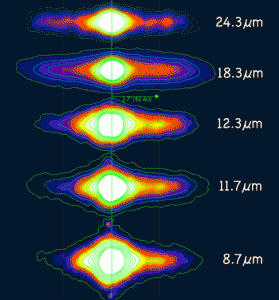The dust disk around the star Beta Pictoris has been under study since 1983, when it was detected in IRAS (Infrared Astronomy Satellite) data. Last October, astronomers in Japan found three rings of planetismals circling the star, with a possible planet at 12 AU. Now the Gemini South 8-meter telescope in Chile has found telling new details in the disk. The upshot: a collision between large planetary bodies may have occurred there within the last few decades.
This is intriguing news for those scientists who believe such collisions are a necessary part of planetary formation. From a Gemini Observatory news release:
“It is as if we were looking back about 5 billion years and watching our own solar system as it was forming into what we see today,” said Dr. Charles Telesco of the University of Florida who led the team. “Our research is a bit like a detective dusting for fingerprints to figure out a crime scene, only in this case we use the dust as a tracer to show what has happened within the cloud. The properties of the dust show not only that this was a huge collision, but that it probably happened recently in both astronomical and even human timescales.”
 The clue to the recent collision is the lopsided nature of the debris disk, and the presence of fine dust grains in one part of it. Such tiny particles should have been pushed away by the parent star long ago. Says team member Dr. Scott Fisher, “The fact that we still see them in our observations means that the collision probably happened in the past 100 years or so. Almost assuredly my grandparents were alive when this collision occurred.”
The clue to the recent collision is the lopsided nature of the debris disk, and the presence of fine dust grains in one part of it. Such tiny particles should have been pushed away by the parent star long ago. Says team member Dr. Scott Fisher, “The fact that we still see them in our observations means that the collision probably happened in the past 100 years or so. Almost assuredly my grandparents were alive when this collision occurred.”
Image: Gemini mid-infrared images of Beta Pictoris as obtained with T-ReCS on Gemini South. Differences in the shape and strength of dust emissions within the disk can be seen as the observed wavelength changes. Note:The clump where the suspected collision occurred is to the right of the central white core at a distance of 52 Astronomical Units (AU). Credit: Gemini Observatory.
More on the new Beta Pictoris findings, which were presented at the recent American Astronomical Society meeting, can be found in the January 13 issue of Nature.

